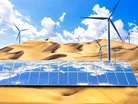How the UAE is leading the world in solar energy use

With the opening this week of Al Dhafra Solar PV Project, the UAE is one step closer to becoming a world leader in solar power generation.
Already home to Noor Abu Dhabi (world’s largest standalone operational solar plant), the UAE has now inaugurated the even larger Al Dhafra – commissioned two additional solar power projects of the same size and scale in Abu Dhabi, and is constructing the five-gigawatt Mohammed bin Rashid Al Maktoum Solar Park in Dubai.
In less than 15 years, the UAE has become a global leader in solar energy, ranked second globally in terms of per capital solar energy consumption, according to the latest data from The Energy Institute Statistical Review of World Energy.
In 2009, Masdar switched on the country's first solar project at 10MW – today, Al Dhafra Solar PV represents a plant that is 200 times that size.
Inaugurated by His Highness Hazza bin Zayed Al Nahyan, Deputy Ruler of Abu Dhabi, the two-gigawatt plant will power 200,000 homes and is expected to reduce Abu Dhabi's carbon dioxide emissions by more than 2.4 million tonnes a year.
That’s equivalent to removing some 470,000 cars from the road.
The project was made possible thanks to the strategic partnership of Abu Dhabi energy giant TAQA, which owns 40%, clean energy champion Masdar (20%), France’s EDF Renewables (20%) and China's JinkoPower (20%).
First announced in 2020, the project has broken records in terms of cost for utility-scale solar projects. Initially with a highly competitive solar power tariff of US$1.35 cents/kWh, which improved to US$1.32 cents/kWh upon financial close.
As Chairman of Masdar and COP28 President-Designate, HE Dr Sultan Al Jaber says the new solar plant demonstrates “remarkable progress in solar power efficiency, innovation and cost competitiveness – setting a new record-low tariff” and is an example of the scale of the ambition needed around the world.
This comes just days before the opening of COP28 UAE, where Al Jaber is expected to call for the world to unite and deliver the energy transition by tripling renewable capacity and doubling energy efficiency by 2030.
The UAE was the first country in the MENA region to announce a target of net zero by 2050 and has been investing heavily in building renewable energy plants, recently announcing improved targets in the generation of renewables.
Abu Dhabi and the UAE at forefront of renewables
Since 2009, when Masdar switched on the country's first solar project, Abu Dhabi (and the wider UAE) has been on a mission to make renewables – and solar in particular – central to its decarbonisation strategy.
In 2012, HH Sheikh Mohammed bin Rashid Al Maktoum announced the launch of the Mohammed bin Rashid Al Maktoum Solar Park in Dubai. This year saw the completion of the fifth phase with capacity of 900MW, providing clean energy to about 270,000 Dubai homes, and reducing carbon emissions by 1.18 million tonnes annually. The planned capacity is 5,000 MW by 2030, expected to reduce 6.5 million tonnes of carbon emissions annually.
And in 2019, Emirates Water and Electricity Company (EWEC), in partnership with Japan’s Marubeni Corp and China’s Jinko Solar Holding, announced full operations of Al Noor, with the aim of reducing Abu Dhabi’s CO2 emissions by 1 million metric tons, equivalent to removing 200,000 cars from the roads, and powering the demands of 90,000 people.
This year, the UAE updated its National Energy Strategy 2050, with plans to invest up to US$54 billion by 2030 to ensure energy demand is met while also maintaining economic growth. Among new goals, tripling renewable energy capacity to 14GW by 2030 and raising the percentage of clean energy in the total energy mix to 30% by 2031.
The UAE recently launched its first wind programme, with Masdar announcing a 103.5-megawatt landmark wind project across four locations in Abu Dhabi, with the project expected to power some 23,000 homes a year, displacing 120,000 tonnes of CO2.
As a major player in the UAE’s switch to renewables, Masdar is striving towards a renewable energy portfolio capacity of around 100 gigawatts by 2030 along with an annual green hydrogen production capacity of up to one million tonnes.
The other major player, TAQA – one of the largest integrated utilities in Europe, the Middle East and Africa – is looking to achieve 150 gigawatts of gross power generation by 2030 and now counts two of the world’s largest solar projects in its portfolio.
"We are witnessing, day after day, project after project, that the UAE is at the global forefront of developing and adopting innovative clean energy solutions. We are achieving energy security, while also contributing to building a bright future for future generations to come." HH Sheikh Hazza Bin Zayed Al Nahyan said.
Featured Articles
SAP has announced it has appointed a new President for a newly-created EMEA region, aiming to make the most of the opportunities of cloud and AI
technology
From fighter pilot to fashion house financier, Mohammed Alardhi has taken Investcorp to great heights – so what’s the secret to his success?
Dr Omar Al-Attas, Head of Environmental Protection and Regeneration at Red Sea Global, shares his COP28 hopes and approach to regenerative tourism
strategy


